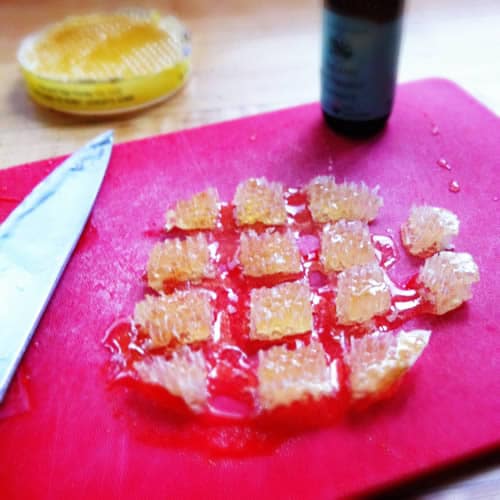Homemade Honeycomb Gum
Oct 30, 2012, Updated May 13, 2014
Linda Miller Nicholson writes the aptly named blog Salty Seattle, and is known as much for her sassy stilettos as her sous-vide. She’s a conscious omnivore, food-sorceress, and slow-food salt-maker. She lives in Seattle, Washington, with her husband Jonas and their toddler Bentley Danger. (Yes, that’s really his name). You can catch up with her, or at least try to, on Twitter.

It’s nearing the end of October Unprocessed and I have to confess, I’ve cheated a few times. Have you? The bag of Reese’s Peanut Butter Cups hanging out in the back of the pantry has a Siren-like pull on my Odyssean resolve, and yes, I’ve given in to those chocolatey, peanut buttery charms, but not without guilt. I’ve managed to plan my days very well so that I limit opportunities for transgression, but they still crop up.
One of my biggest transgressions happened for the sake of fresh breath and clear ears while on a flight. I’m talking about that necessary evil, gum. While technically we don’t actually eat gum (my four-year-old might beg to differ), it still unleashes a whole host of unprocessed garbage into our systems when we chew it, so I set out to find a more natural means of taming the Halitosis Hobgoblin.
Gum originally came from chicle, which is derived from the milky juice of the tropical Sapodilla tree. I didn’t think it would be practical to fly to the Amazon and harvest chicle for the sake of one blog post; surely locavorism is a cog on the wheel of eating unprocessed. There are chicle-containing kits available online for making your own gum, but they struck me as gimmicky and full of unnecessary ingredients.
Whenever I’m stymied, I do a little exercise where I channel my childhood self and ask her what she would do. Usually I hit upon obvious solutions to the biggest of my big girl problems. The gum solution came in the form of waxed lips. Remember waxed lips? I could chew on those things for hours, which is really kind of gross if you think about it as a sort of sicko precursor to making-out (I’ve improved my technique, I promise).
I’m not sure how highly processed wax lips are, but I do know that honeycomb is hardly manipulated, unless the bee who threw up the honey happened to be bulimic or something, in which case, watch for ipecac. So I set out to find the right kind of beeswax to make gum. It turns out that if you want to get the most bang for your honey-gum-buck, you need to buy “comb honey,” not the kind that floats on top of jars of honey, which just doesn’t yield enough comb to make a practical amount of gum. I found comb honey by Mountain Star out of Idaho, but I’d highly encourage you to go as local as you can.
There is some serious rocket science that goes into making honey gum, so I assembled a crack team of Mars Rover madmen to help me prove the formula. The recipe is now a closely guarded national secret, but I’m going to share it with you because I’m a giver.
First you cut the honeycomb into gum-like chunks. Go big. Mastication reduces mass (clinical-sounding words courtesy of team Rover). Then you may chew them as-is, or drop tiny globules of flavored extract on them if you are going for that stay-fresh vibe. You might try peppermint or cinnamon extract. Make your own or get the good stuff from the co-op. I wrapped my honey gum in little sheets of parchment tied with ribbons.
Team Rover laughed at me and said that the better way to package them would be to cryogenically freeze them, shoot them into space with a planet canon, then bounce them off a moonerang (that’s a moon boomerang for the uninitiated) so that they come home sealed in astral vac pacs. You can choose which packaging you think is more practical.
Now here’s the part where I drop science, so listen up. Honey gum is better than regular gum for a number of reasons.
Did you know that gum is not great for you because you’re not supposed to chew without actually eating something? Chewing activates digestive enzymes, and if you do it without eating, you’re wasting those valuable enzymes for naught. Honey gum contains real food (bee puke), so those with digestive issues may find it more tummy soothing than commercially available gum.
Honey gum is biodegradable. If you stepped in it, all you’d get is a little shine to the bottom of your shoe, not a stretchy, stroppy mess. Also, you can eat it, so if you have a kid who swallows, or if you just really like to swallow because you manifest your bedroom habits in your daily life, then this IS the droid you’re looking for.
Are you a super hippie? Honey gum has something for you, too. You can upcycle it! Yes, you can reuse spent honey gum that has been rode hard and put away yet. You might want to let it dry first, though. It makes a great shoeshine wax, or you could even melt it into candles. The possibilities are endless with this stuff. Is it too late to file a patent?
One last fun factoid: If you buy local honeycombs, in addition to supporting community agriculture, you are eating honey that contains pollen that can lessen airborne allergies.
I’m pretty sure you’re not reading this sentence because you’re off trying to sustainably source honeycomb so that you, too, can enjoy ambrosial nectar breath in elevators, on planes, and during meetings with close-talkers, but I’d just like to say that until next time, chew harder, kids, chew harder.






















Hilarious and very informative post! Thank you very much!
OMG. I laughed so hard and shared the humor with my 13 year old! Thank you!